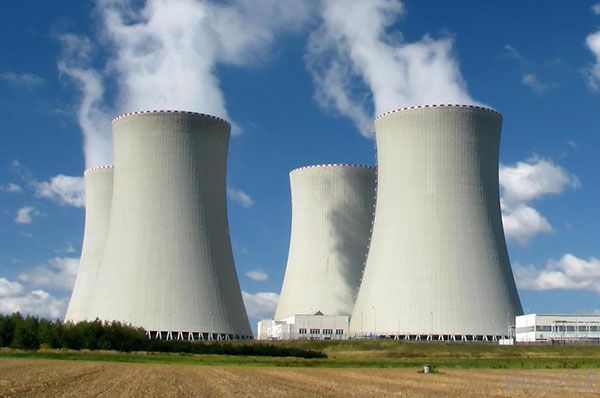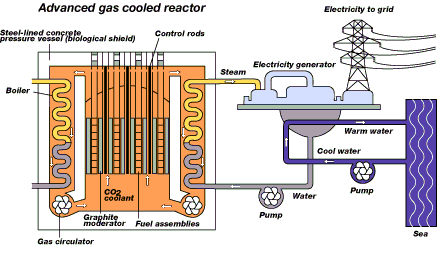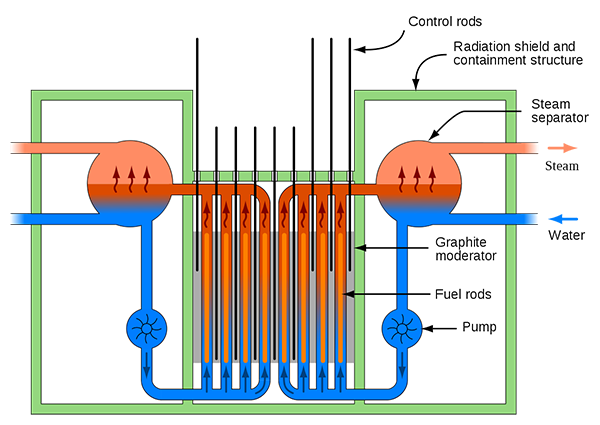Types of Nuclear Reactors
Nuclear reactors are devices in which the chain reaction is begun and maintained in a continuous and supervised manner. Nuclear reactors are sometimes used as power plants where nuclear energy is converted to another kind of energy (usually electricity). This is the definition of nuclear reactors but let's look at some of the most general definitions before that.

Nuclear energy is the energy generated during atomization (fusion) or fusion (fusion) of atoms. This definition is important to us. The Nuclear Power Plant (Reactor) is the name given to facilities that produce electricity from the heat generated by nuclear reaction assistance. Nuclear reactors are systems in which the post fission chain cleavage reaction is controlled. To understand the significance of the partitioning reaction, it is sufficient to note that the combustion of a 1 kg U235 isotope is equivalent to approximately 1.3 million kilograms of coal in the resulting energy.
The first controlled cleavage reaction was carried out on the CPI Trial Reactor, which was built in the United States in 1942. Graphite was used as natural uranium and moderator (retarder) as fuel material in this reactor. As in the first nuclear reactor, nuclear reactor designers' choices for reactor fuel are natural uranium (0.71% U235, 99.27% U238) or 3%, 4% enriched uranium. If natural uranium is selected as fuel, graphite or heavy water should be used as moderator.

Gas Cooled Reactors (GCR)

The energy produced in nuclear fuels is drawn off using the gas form of the fluid in gas cooled reactors. Graphite is used to slow neutrons.
Advantages
- Cooler is cheaper
- Any fuel, including natural uranium can be used
- Very little wear and tear on refrigerant system components
- High efficiency (> 40%) due to high refrigerant temperature
- Gas turbine can be used
Disadvantages
- Large and expensive reactor core and heat exchangers
- Low fuel burn rates
- Graphite retarding combustible material
Pressurized Water Reactors (PWR)

The pressurized reactors use 3 percent enriched uranium. The reaction is slowed with normal water and cooled.
Advantages
- More experience thanks to widespread use
- Light water is cheap and the properties are well known.
- A smaller core
- Fission products remain in the first cooling cycle.
Disadvantages
- High system pressure requires stronger and more expensive piping and pressure vessel
- Reactor must be closed for fuel loading
- Enriched fuel
High Power Channel Reactor (RBMK)
The RBMK (Russian: Реактор Большой Мощности Канальный Reaktor Bolshoy Moshchnosti Kanalnyy, “High Power Channel-type Reactor”)[1]

The pressure tubes pass through the graphite retarder in this reactors. Boiling water is circulated to cool the fuel, which consists of lightly enriched uranium in these tubes.
Advantages
- Due to the separate pressure tubes, a large number of channels can be accommodated and can be reached with great power
- Can be fueled during operation
- Any fuel, including natural uranium can be used
Disadvantages
- The control of the very large reactor core is difficult
- The difference between the coolant and the retarder causes a positive space coefficient
- Graphite retarder is a flammable material
- The design does not contain the reactor building against the big accident
Heavy Water Reactors (CANDU)
The CANDU, for Canada Deuterium Uranium, is a Canadian pressurized heavy water reactor design used to generate electric power. [2]

Heavy water reactors are reactors that use heavier water (D2O) as a coolant and retarder in their designs, which have very similar physical and thermodynamic properties to water but have different neutronic properties.
Advantages
- Heavy water is an excellent moderator
- Any fuel, including natural uranium can be used
- Fission products remain in the first cooling cycle
- Can be fueled during operation
- The moderator can be used to draw too much heat in the event of the coolant loss
Disadvantages
- Heavy water cost is big
- System sealing against heavy water loss is required during fuel loading operations
- High first cooling circuit pressure
- Big core
Apart from these there are also new reactors.
- Rapid productive reactors
- High temperature reactors
The first group of advanced designs is called "3rd Generation Reactors" and their first examples started commercial operation since 1996. The "4th Generation Reactors" group is still in conceptual design phase.
Image Sources: 1, 2, 3, 4, 5, 6
This post has received gratitude of 45.45 % from @appreciator thanks to @kedi.
This post has received a 2.43 % upvote from @buildawhale thanks to: @kedi. Send at least 1 SBD to @buildawhale with a post link in the memo field for a portion of the next vote.
To support our daily curation initiative, please vote on my owner, @themarkymark, as a Steem Witness
Congratulations @kedi! You have completed some achievement on Steemit and have been rewarded with new badge(s) :
Click on any badge to view your own Board of Honor on SteemitBoard.
For more information about SteemitBoard, click here
If you no longer want to receive notifications, reply to this comment with the word
STOP